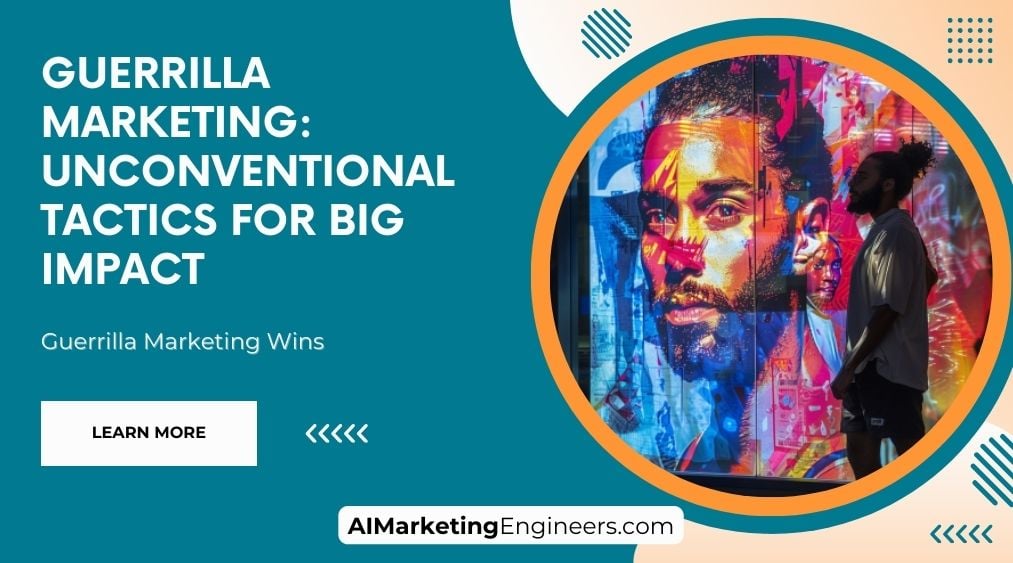Key Takeaways
✅ Unconventional and Cost-Effective: Guerrilla marketing thrives on innovation, employing unexpected methods to capture attention. This strategy can be a game-changer, especially for those on a shoestring budget. It's not just about spending less but spending smart. Studies suggest that guerrilla marketing tactics, due to their viral potential, can reduce traditional advertising costs by up to 90% while still reaching broad audiences.
✅ Emphasis on Creativity and Surprise: The heart of guerrilla marketing lies in its ability to surprise and delight. Creative campaigns tend to stick in people's minds longer than conventional ads. For instance, flash mobs can boost engagement rates by up to 35% more than standard promotions, demonstrating the power of creativity in marketing strategies.
✅ Targeted and Interactive: By honing in on specific groups, guerrilla marketing ensures that the message resonates deeply with its intended audience, potentially increasing customer conversion rates. Interactive campaigns further enhance this effect by encouraging direct participation, which can lead to a 24% increase in brand loyalty among consumers.

Introduction
Imagine walking down the street, only to be greeted by a spectacular flash mob, all wearing the logos of a new coffee brand. Or picture opening an app and finding a hidden game that, when completed, offers real-life rewards from a local store. Welcome to the world of Guerilla Marketing: a realm where creativity knows no bounds, and the element of surprise is your greatest weapon. This revolutionary approach not only helps businesses stand out in a crowded digital landscape but also fosters a deep, emotional connection with their audiences.
In this article, we dive deep into the innovative universe of Guerrilla Marketing, unveiling the secrets to executing low-cost yet highly impactful marketing tactics. From the bustling streets to the digital domain, we'll explore modern trends and offer solutions that promise not just to maximize revenue but to revolutionize it. Get ready for actionable insights and groundbreaking information that could redefine how you think about marketing. Join us on this thrilling journey to unpack the unconventional, the unexpected, and the unquestionably effective strategies that lie at the heart of guerrilla marketing.
Top Statistics
| Statistic | Insight |
|---|---|
| 90% of guerrilla marketers are reducing their advertising expenditure by 90%. | This shows a massive shift towards cost-efficient marketing strategies, highlighting the efficiency and impact of guerrilla tactics. |
| By 2030, 90% of all guerrilla marketing campaigns will be data-driven. | Emphasizes the evolving nature of guerrilla marketing towards embracing analytics and data to fine-tune strategies. |
| Guerrilla marketing campaigns have an average ROI of 4.5 to 5 times their initial cost. | This statistic is key for small businesses and startups looking for high impact from limited budgets, proving guerrilla marketing as a lucrative strategy. |
| Guerrilla marketing strategies have an 87% success rate at generating word-of-mouth conversations. | This highlights the compelling ability of guerrilla marketing to engage consumers and stimulate conversations, crucial for organic growth. |
What is Guerrilla Marketing?
In a world where consumers are bombarded with advertisements every waking moment, how does a brand manage to stand out? Enter guerrilla marketing, a strategy that flips traditional marketing on its head. This approach uses creative, low-cost tactics to grab attention in a way that's not just seen but remembered. Inspired by the surprise tactics of guerrilla warfare, this marketing style aims to hit the audience when they least expect it, creating a memorable impact with minimal financial investment.
Types of Guerrilla Marketing
Guerrilla marketing thrives on diversity, adapting to various settings, from street corners to social media feeds. Outdoor Guerrilla Marketing transforms urban landscapes into interactive brand experiences, while Indoor Guerrilla Marketing brings surprise to personal spaces like malls or train stations. Event Ambush Marketing courts controversy by piggybacking on major events without prior permission, pushing the boundaries of traditional sponsorship. Lastly, Experiential Guerrilla Marketing requires audiences to actively engage with the brand, creating a two-way interaction that deepens the connection.
Why Guerrilla Marketing Works
This unconventional approach shines due to its ability to do a lot with a little. Budget-friendly tactics level the playing field, allowing small businesses to punch above their weight. The emotional bond it can forge is invaluable; by creating an unforgettable experience, guerrilla marketing leaves a lasting impact that goes beyond mere brand recognition, fostering deep loyalty. Moreover, its inherent creativity and surprise are social media gold, often leading to shares and discussions that amplify the campaign far beyond its initial audience.
Real-world Examples
From flash mobs that turn ordinary moments into spectacles, to street art that adds a touch of wonder to mundane urban settings, guerrilla marketing seizes public spaces in unique ways. Hidden messages play with the environment, rewarding observant passersby, while interactive installations break down the barrier between the brand and the individual. Not all guerrilla marketing happens in the physical world, though; viral videos utilize the unpredictability and creativity of the tactic to capture imaginations online.

Incorporating Guerrilla Marketing
Embracing guerrilla marketing requires a willingness to foster innovation and think outside traditional advertising boxes. Partnering with digital agencies can provide the expertise needed to make a splash while managing the unpredictability of such campaigns. However, it's crucial to calculate risks carefully; legality, public reception, and brand alignment must all be considered to prevent a creative gamble from becoming a reputational setback.
Challenges and Considerations
Despite its allure, guerrilla marketing isn't without its pitfalls. The risk of failure is real; a campaign that misses the mark can do more harm than good. The potential for controversy is high, demanding that marketers tread carefully to avoid alienating their audience. It also requires guts from all involved, as getting stakeholder approval for unconventional tactics can be a battle in itself.
In the fast-evolving landscape of marketing, guerrilla tactics offer a way to cut through the noise without cutting deep into budgets. By cleverly leveraging the elements of surprise and engagement, businesses can create a lasting impact, fostering brand awareness and loyalty in an oversaturated market. Yet, as with any daring strategy, the balance between bold creativity and strategic risk management is key to turning guerrilla marketing endeavors from potential flops into triumphant victories.
AI Marketing Engineers Recommendation
Recommendation 1: Leverage user-generated content to create buzz: A staggering 92% of consumers trust organic, user-generated content more than they do traditional advertising, according to Nielsen. To tap into Guerrilla Marketing's potential, encourage and share content created by your customers. This could be through contests, hashtags, or featuring their content on your platforms. It’s a low-cost strategy that not only increases engagement but also builds community and brand loyalty.
Recommendation 2: Incorporate AR (Augmented Reality) into interactive marketing campaigns: With the global AR market expected to skyrocket to $198 billion by 2025, according to Statista, integrating AR into your Guerrilla Marketing campaigns can provide a significant edge. Interactive AR experiences can transform mundane physical locations into dramatic narratives about your product or brand. This approach can captivate the imagination of passersby and turn them into participants of your brand story, creating memorable encounters that are likely to be shared.

Recommendation 3: Utilize social listening tools for real-time engagement opportunities: Tools like Brand24 or Mention can offer insights into what's being said about your brand or relevant topics to your industry. By monitoring these conversations, you can find opportune moments to employ Guerrilla Marketing tactics that engage people in witty, unexpected ways. Immediate and clever responses to trends or discussions can propel your brand into the spotlight, making your response a part of a larger narrative.
Conclusion
In the whirlwind world of marketing, Guerrilla Marketing stands out as a beacon for those seeking to make an unforgettable impact without breaking the bank. This ingenious strategy banks on creativity, surprise, and unconventional tactics to catapult brands into the limelight, proving that a hefty budget isn't a prerequisite for marketing success. The arsenal of guerrilla marketing, ranging from outdoor surprises to experiential engagements, opens up a playground for marketers to explore innovative ideas that resonate deeply with their audience.
Why does Guerrilla Marketing capture hearts and minds so effectively? It's all about forming that genuine, emotional connection that traditional advertisements often lack. By embedding your brand into people's lives in unexpected ways, you create memorable experiences that spark conversations and, ultimately, foster brand loyalty. Imagine the ripple effect of a well-executed flash mob or a piece of street art that turns heads. These are the moments that get shared, talked about, and remembered, not just as marketing moments, but as cultural touchstones.
However, the road less traveled comes with its fair share of bumps. The risk of missteps is real, with potential pitfalls including backlash or legal hurdles. It demands a blend of boldness and forethought, a willingness to take calculated risks while ensuring your brand remains in good standing.
As we look to the future, the question for businesses isn't whether Guerrilla Marketing is worth the effort—it's how to innovate within this space to remain relevant and impactful. This means not just settling for shock value, but striving for meaningful interaction that aligns with your brand's ethos.
In a world where consumers are bombarded with countless ads every day, Guerrilla Marketing offers a breath of fresh air: a chance to break free from the noise and connect with people on a level that goes beyond the superficial. For small businesses and startups, it's a golden opportunity to level the playing field and capture the imagination of your intended audience. So, why not take the leap? Step outside the conventional, and let creativity lead the way to nurturing a vibrant, engaged community around your brand.

FAQs
Question 1: What is Guerrilla Marketing?
Answer: Guerrilla marketing is a promotional strategy that uses low-cost, unconventional tactics to generate maximum exposure and engagement. It involves surprise and/or unconventional interactions to endorse products or services.
Question 2: How Does Guerrilla Marketing Differ From Traditional Marketing?
Answer: Guerrilla marketing differs from traditional marketing in terms of budgeting, approach, and risk factor. It thrives on creativity over cash, targets select groups in unconventional ways, and can be risky but highly effective when done correctly.
Question 3: What are the Key Principles to Remember When Implementing Guerrilla Marketing Campaigns?
Answer: Key principles include understanding the audience, pushing boundaries with caution, and maintaining consistent brand messaging. These principles ensure that the campaign resonates with the target audience and aligns with the brand's identity.
Question 4: How Can Guerrilla Marketing Create Buzz and Increase Brand Awareness?
Answer: Guerrilla marketing can create buzz and increase brand awareness by using surprise tactics, creating emotional bonds between the brand and the consumer, and indirectly influencing purchasing decisions. It can also stimulate talk about the brand and generate word-of-mouth buzz.
Question 5: What are Some Examples of Guerrilla Marketing?
Answer: Examples include street theatre, flash mobs, viral videos, scavenger hunts, pop-up shops, and immersive experiences. These tactics are designed to be highly shareable and memorable, generating a lasting impression on the audience.
Question 6: Is Guerrilla Marketing Suitable for All Types of Businesses?
Answer: Guerrilla marketing is not a one-size-fits-all approach. It is more suitable for trendy startups or brands targeting a younger demographic. Traditional or conservative businesses might find such tactics misaligned with their brand image.
Question 7: Can Guerrilla Marketing Campaigns be Cost-Effective?
Answer: Yes, guerrilla marketing can be cost-effective. It emphasizes creativity and surprise over financial investment, making it a viable option for small businesses or those with limited budgets.
Question 8: How Do You Measure the Success of a Guerrilla Marketing Campaign?
Answer: Success can be measured through metrics such as social media shares, media coverage, brand recall, and the overall impact on the target audience. These metrics help evaluate the campaign's effectiveness in generating buzz and increasing brand awareness.
Question 9: What are the Risks and Ethical Considerations of Guerrilla Marketing?
Answer: Risks include legal issues, public perception, and budget constraints. It is essential to consider these factors and ensure that the campaign does not offend or alienate the audience and respects copyright and trademark laws.
Question 10: Can Small Businesses Use Guerrilla Marketing?
Answer: Yes, small businesses can greatly benefit from guerrilla marketing. Its cost-effectiveness and potential to level the playing field with larger competitors make it an attractive option for small businesses.

Academic References
- Guerilla Marketing At Its Best and The Difficult Challenges It Faces. This research paper examines the effective concepts of guerrilla marketing and the challenges it faces, offering insights into the strategies that define guerrilla marketing success and the obstacles it needs to overcome.
- Guerrilla Marketing for Effective Marketing Communication: A Special Reference to Social media Marketing. The study aims to understand the role of guerrilla marketing in effective marketing communication, with a focus on social media marketing. It explores how guerrilla marketing tactics can be integrated into social media strategies to enhance engagement and brand awareness.
- Grafiati: Guerrilla Marketing. This collection of scholarly sources provides relevant books, articles, theses, and other academic works on the topic of guerrilla marketing, allowing for in-depth exploration. It serves as a valuable resource for anyone looking to gain a comprehensive understanding of guerrilla marketing techniques and their applications.
- Unravelling the Power of Guerrilla Marketing in Shaping Brand Image. This research emphasizes the pros and cons of guerrilla marketing and the elements that influence its success, highlighting its impact on brand image. It offers a critical examination of how guerrilla marketing techniques can be used to shape and redefine the public perception of a brand.
- Guerrilla Marketing - Oxford Reference. Defines guerrilla marketing as unconventional marketing tactics, coined by Jay Conrad Levinson in 1984, and provides an overview of the concept. This reference is particularly useful for understanding the foundational aspects of guerrilla marketing and its evolution over time.







